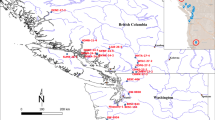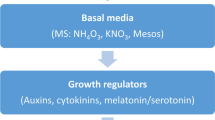Abstract
The constitutive pyrrolizidine alkaloid (PA) concentration of both shoots and roots differed significantly between 17 selfed families. The broad-sense heritability accounted for 33–43% of the variation in PA levels. Families also differed significantly in the amount and the direction of PA induction in both shoots and roots, 24 h after punching 15 holes in the leaves. We found a significantly negative relationship between the changes in PA content of the shoots and changes in PA content of the roots. The total PA content of the plants did not increase. We thus concluded that changes in PA distribution over the plant resulted from transport of PAs within the plant. The direction of transport differed between families: some transported PAs to the shoots, others to the roots. This makes it questionable whether PAs act as damage-induced defences. The effect of damage on the PA concentration is far less than the differences found between families in the constitutive PA concentration. This again strongly suggests that damage-induced defences inCynoglossum officinale do not play an important role. We argue that the general lack of attention that is given to genotype in induction experiments, has led to false conclusions.
Similar content being viewed by others
References
Aerts RJ, Snoeijer W, van der Meijden E, Verpoorte R (1991) Allelopathic inhibition of seed germination byCinchona alkaloids? Phytochemistry 30: 2947–2951
Baldwin I (1991) Damage-induced alkaloids in wild tobacco. In: Tallamy DW and Raupp MJ (eds) Phytochemical induction by herbivores. Wiley, New York, pp 47–69
Bentley MD, Leonard DE, Stoddard WF, Zalkow LH (1984) Pyrrolizidine alkaloids as larval feeding deterrents for spruce budworm,Choristoneura fumifera (Lepidoptera: Tortricidae). Ann Entomol Soc Am 77: 393–397
Berenbaum MR (1991) Coumarins. In: Rosenthal GA, Berenbaum MR (eds) Herbivores. Their interaction with secondary plant metabolites. I: The chemical participants. Academic Press, San Diego, pp 221–249
Boppré M (1986) Insect pharmacophagously utilizing defensive plant chemicals (pyrrolizidine alkaloids). Naturwissenschaften 73: 17–26
Coleman JS, Jones CG (1991) A phytocentric perspective of phytochemical induction by herbivores. In: Tallamy DW and Raupp MJ (eds) Phytochemical induction by herbivores. Wiley, New York, pp 3–46
De Jong TJ, Klinkhamer PGL, Boorman LA (1990) Biological flora of the British Isles.Cynoglossum officinale L. J Ecol 78: 1123–1144
Dreyer DL, Jones KC, Molyneux RJ (1985) Feeding deterrency of some pyrrolizidine, indolizidine, and quinolizidine alkaloids towards pea aphid (Acyrthosiphon pisum) and evidence for phloem transport of indolizidine alkaloid swainsonine. J Chem Ecol 11: 1045–1051
Fagerström T, Larsson S, Tenow O (1987) On optimal defence in plants. Funct Ecol 1: 73–81
Hartmann T (1991) Alkaloids. In: Rosenthal GA, Berenbaum MR (eds) Herbivores. Their interactions with secondary plant metabolites. I: The chemical participants. Academic Press, San Diego, pp 79–121
Hartmann T, Ehmke A, Eilert U, von Borstel K, Theuring C (1989) Sites of synthesis, translocation and accumulation of pyrrolizidine alkaloid N-oxides inSenecio vulgaris L. Planta 177: 98–107
Jermy T (1984) Evolution of insect/host plant relationships. Am Nat 124: 609–630
Karban R, Myers JH (1989) Induced plant responses to herbivory. Annu Rev Ecol Syst 20: 331–348
Lawrence MJ (1984) The genetical analysis of ecological traits. In: Shorrocks B (ed) Evolutionary ecology. Blackwell, Oxford, pp 27–63
Mattocks AR (1967) Spectrophotometric determination of unsaturated pyrrolizidine alkaloids. Anal Chem 39: 443–447
Mattocks AR (1986) Chemistry and toxicology of pyrrolizidine alkaloids. Academic Press, London
Rhoades DF, Cates RG (1976) Toward a general theory of plant antiherbivore chemistry. Recent Adv Phytochem 10: 168–213
Rohlf FJ, Sokal RR (1981) Statistical Tables, 2 ed. Freeman, New York
Simms EL (1992) Costs of plant resistance to herbivory. In: Fritz S, Simms EL (eds) Plant resistance to herbivores and pathogens. The University of Chicago Press, Chicago, pp 363–391
Sokal RR, Rohlf FJ (1981) Biometry (2 edn). Freeman, New York, 860
Speiser B, Harmatha J, Rowell-Rahier M (1992) Effects of pyrrolizidine alkaloids and sesquiterpenes on snail feeding. Oecologia 92: 257–265
Steiner AA (1968) Soilless culture. Proceedings of the Sixth Colloquial International Potash Institute, Florence, Italy. International Potash Institute, Bern, Switzerland, pp 324–341
Tallamy DW (1985) Squash beetle feeding behaviour: an adaptation against induced cucurbit defenses. Ecology 66: 1574–1579
Van Dam NM, Bhairo-Marhé SK (1992) Induced chemical defence inCynoglossum officinale. In: Menken SBJ, Visser JH, Harrewijn P (eds) Insect-plant relationships. Kluwer, Dordrecht, pp 79–82
Van Dam NM, Van der Meijden E, Verpoorte R (1993) Induced defences in three alkaloid containing plant species. Oecologia 95: 425–430
Vrieling K, van Wijk CAM (1994) Cost assessment of the production of pyrrolizidine alkaloids in ragwort (Senecio jacobaea L.). Oecologia (97: 541–546)
Vrieling K, Smit W, van der Meijden E (1991a) Tritrophic interactions between aphids (Aphis jacobaeae Schrank), ant species,Tyria jacobaeae L., andSenecio jacobaea L. lead to maintenance of genetic variation in pyrrolizidine alkaloid concentration. Oecologia 86: 177–182
Vrieling K, Soldaat LL, Smit W (1991b) The influence of pyrrolizidine alkaloids ofSenecio jacobaea onTyria jacobaeae, Brachycaudus cardii andHaplothrips senecionis. Neth J Zool 41: 228–239
Vrieling K, de Vos H, van Wijk CAM (1993) Genetic analysis of the concentrations of pyrrolizidine alkaloids inSenecio jacobaea. Phytochem, 32: 1141–1144
Wink M (1993) Allelochemical properties or the raison d'être of alkaloids. In: Cordell GA (ed) The alkaloids, vol 43. Academic Press, San Diego, pp 1–118
Wolff K, van Delden W (1987) Genetic analysis of ecologically relevant morphological variability inPlantago lanceolata L. I. Population characteristics. Heredity 58: 183–192
Zangerl AR, Bazzaz FA (1992) Theory and pattern in plant defense allocation. In: Fritz S, Simms EL (eds) Plant resistance to herbivores and pathogens. The University of Chicago Press, Chicago, pp 363–391
Zangerl AR, Berenbaum MR (1990) Furanocoumarin induction in wild parsnip: genetics and populational variation. Ecology 71: 1933–1940
Author information
Authors and Affiliations
Rights and permissions
About this article
Cite this article
van Dam, N.M., Vrieling, K. Genetic variation in constitutive and inducible pyrrolizidine alkaloid levels inCynoglossum officinale L.. Oecologia 99, 374–378 (1994). https://doi.org/10.1007/BF00627751
Received:
Accepted:
Issue Date:
DOI: https://doi.org/10.1007/BF00627751




